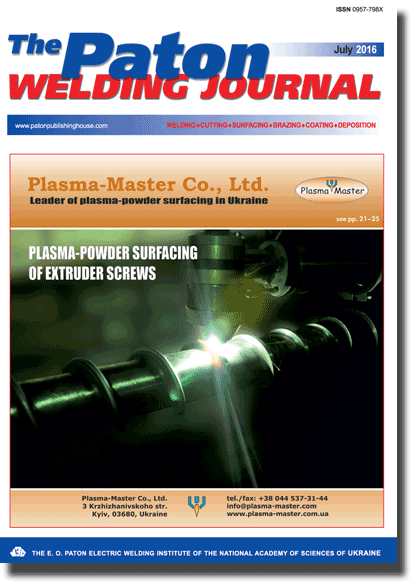| 2016 №07 (07) |
DOI of Article 10.15407/tpwj2016.07.08 |
2016 №07 (09) |

The Paton Welding Journal, 2016, #7, 42-46 pages
Application of robotic and mechanized welding under disturbing factor conditions
E.V. Shapovalov, V.V. Dolinenko, V.A. Kolyada, T.G. Skuba And F.S. Klishchar
E.O. Paton Electric Welding Institute, NASU, 11 Kazimir Malevich Str., 03680, Kiev, Ukraine. E-mail: office@paton.kiev.ua
Abstract
The work studies the main problems of automation of processes of multi-pass MIG/MAG welding of large-dimension parts in all spatial positions under conditions of low repeatability of assembly operations. Necessity is shown and, at the same time, insufficiency of application of only laser-television sensor for adapting purpose. A procedure was proposed for equipping a robot-technical (mechanized) welding complex with the computer vision means such as a system of laser-television and video-pyrometric sensors. The results of development of technical means, algorithmic and software support of adaptive welding complex are presented. Proposed control algorithms use the results of on-line measurement of geometry parameters of preparation of butt joint groove as well as position of molten pool. It is shown that the adaptive robotic system performes all the basic functions, typical for it, namely adjustment of electrode position and parameters of welding mode under disturbing factor conditions, and is capable to provide necessary geometry and mechanical characteristics of the weld. As an example, this work uses a robotic complex of ABB company, including welding robot ABB IRB-1600, equipped with laser-television and video-pyrometric sensors, and arc power source ESAB Aristo MIG 5000I. The welding experiments showed that the developed software and hardware allow adapting robotic technical complex for application in welding of butt joints under effect of disturbing factors such as gap size change, distortion of electrode wire, ambient temperature change etc. 8 Ref., 6 Figures.
Keywords: welding robot, manipulator, geometry and technical adapting, automatic control system, operator interface
Received: 26.01.16
Published: 02.08.16
References
- Gladkov, E.A., Brodyagin, V.N., Perkovsky, R.A. (2014) Automation of welding processes. Moscow: N.E. Bauman MGTU.
- Fernando de Aguiar Faria, Abraao Marques Tavares, Marina Spyer Las Casas (2010) Machine vision and artificial neural networks for seam tracking and weld inspection. ABCM Symp. Series in Mechatronics, Vol. 4, 768–775.
- Xiao, Z.W., Tarn, T.-J. et al. (2010) Research on a trilines laser vision sensor for seam tracking in welding: Robotic welding, intelligence and automation. LNEE, Vol. 88, 139–144.
- Moon, H.S., Beattie, R.J. (2002) Development of adaptive fill control for multitorch multipass submerged arc welding. J. Adv. Manuf. Technol., Vol. 19, 867–872. https://doi.org/10.1007/s001700200098
- Skuba, T.G., Dolinenko, V.V., Kolyada, V.A. et al. (2013) Algorithm of technological adaptation for automated multipass MIG/MAG welding of items with a variable width of edge preparation. The Paton Welding J., 1, 14–20.
- (2013) Robotics application manual. FlexPendant SDK RobotWare: Doc. ID 3HAC036958-001, Rev. B.
- (2013) Robotics technical reference manual. RAPID instructions, functions and data types RobotWare: Doc. ID 3HAC16581-1, Rev. P.
- (2013) Robotics application manual. Arc and arc sensor RobotWare: Doc. ID 3HAC16591-1, Rev. Q.
Suggested Citation
E.V. Shapovalov, V.V. Dolinenko, V.A. Kolyada, T.G. Skuba And F.S. Klishchar (2016) Application of robotic and mechanized welding under disturbing factor conditions. The Paton Welding J., 07, 42-46.The cost of subscription/purchase order journals or individual articles
| Journal/Currency | Annual Set | 1 issue printed |
1 issue |
one article |
| TPWJ/USD | 384 $ | 32 $ | 26 $ | 13 $ |
| TPWJ/EUR | 348 € | 29 € | 24 € | 12 € |
| TPWJ/UAH | 7200 UAH | 600 UAH | 600 UAH | 280 UAH |
| AS/UAH | 1800 UAH | 300 UAH | 300 UAH | 150 UAH |
| AS/USD | 192 $ | 32 $ | 26 $ | 13 $ |
| AS/EUR | 180 € | 30 € | 25 € | 12 € |
| SEM/UAH | 1200 UAH | 300 UAH | 300 UAH | 150 UAH |
| SEM/USD | 128 $ | 32 $ | 26 $ | 13 $ |
| SEM/EUR | 120 € | 30 € | 25 € | 12 € |
| TDNK/UAH | 1200 UAH | 300 UAH | 300 UAH | 150 UAH |
| TDNK/USD | 128 $ | 32 $ | 26 $ | 13 $ |
| TDNK/EUR | 120 € | 30 € | 25 € | 15 € |
AS = «Automatic Welding» - 6 issues per year;
TPWJ = «PATON WELDING JOURNAL» - 12 issues per year;
SEM = «Electrometallurgy Today» - 4 issues per year;
TDNK = «Technical Diagnostics and Non-Destructive Testing» - 4 issues per year.


